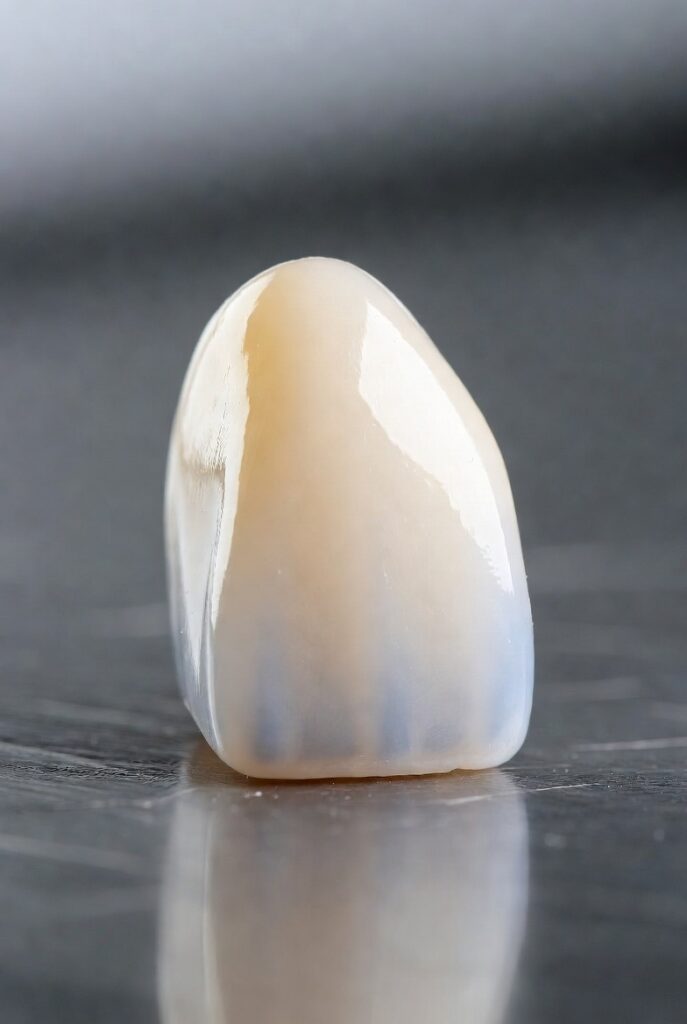Zirconia Crowns, Kitchener, ON
The Modern Powerhouse of Strength and Aesthetics

Zirconia crowns represent the cutting edge of modern restorative dentistry, the perfect union of engineering precision, biocompatibility and natural beauty. Crafted from zirconium dioxide, a ceramic material originally developed for aerospace and orthopedic applications, zirconia crowns have rapidly become the gold standard (pun fully intended) for patients who want durability without metal.
A zirconia crown restores both function and form, fully encapsulating a weakened or damaged tooth to recreate its original contour and strength. Yet unlike traditional metal or porcelain-fused crowns, zirconia combines a translucent, tooth-like appearance with near-unbreakable mechanical resilience, an innovation that truly redefined what “metal-free dentistry” could achieve.
The Science Behind Zirconia
Zirconia is a polycrystalline ceramic, meaning it’s composed of microscopic crystal grains that interlock in a way that resists crack propagation. When stress occurs (from chewing or grinding), the crystals actually transform phase, subtly changing shape to “heal” micro-cracks before they can spread. This property, known as transformation toughening, gives zirconia its remarkable fracture resistance and longevity.
Zirconia’s flexural strength exceeds 900–1200 MPa, far surpassing traditional porcelain and even approaching that of some metals. It’s biocompatible, resists plaque accumulation, and is entirely inert within the mouth, a significant advantage for patients with metal sensitivities or allergies.
Indications and Clinical Applications
Zirconia crowns are suitable for a wide range of restorative needs, including:
- Restoring posterior teeth where biting forces are strongest.
- Full-mouth rehabilitations for heavy grinders or patients with bruxism.
- Cosmetic replacement of metal or PFM crowns in the smile zone.
- Implant-supported restorations requiring strength and precision fit.
- Patients with known metal sensitivities seeking a fully biocompatible option.
Contraindications:
- Extremely limited occlusal space (where material thickness is compromised).
- Situations requiring ultra-translucent enamel mimicry (older monolithic zirconia may appear too opaque, though modern “high-translucency” versions solve this).
Procedure and Fabrication
Zirconia crowns are CAD/CAM milled from pre-sintered blocks using 3D scans of the prepared tooth. After milling, the crown is sintered at high temperatures (around 1,500°C), which hardens the structure and gives it its final strength. Modern milling allows micron-level accuracy, ensuring a precise, gap-free fit that minimizes cement thickness, critical for long-term stability.
Surface glazing or layering with porcelain can add translucency and realism for anterior crowns, but full-contour zirconia (monolithic zirconia) remains the champion for posterior durability.
Advantages: Why Patients Choose Zirconia
- Unparalleled Strength: Resistant to chipping, cracking, or fracturing, even under heavy chewing pressure.
- Aesthetic Realism: The latest multilayered zirconias beautifully mimic the natural gradient of tooth enamel and dentin.
- Biocompatibility: No allergic reactions, no galvanic currents, and excellent gum tissue response.
- Precision Fit: CAD/CAM fabrication ensures marginal accuracy within 20 microns.
- Longevity: Studies show survival rates exceeding 95% after 10 years.
The Psychology of Perfection: Why People Love Zirconia
There is more to Zirconia’s appeal than science, it satisfies a psychological desire for wholeness. Patients who have endured fractured or discolored teeth often view a zirconia crown not merely as a repair but as a restoration of identity and confidence. Its seamless, lifelike finish allows patients to smile freely without self-consciousness, an underrated but profound aspect of modern restorative care.
Culturally, the preference for all-white, metal-free restorations mirrors a societal shift toward “invisible dentistry”: subtle, authentic, and biocompatible. Choosing zirconia is, in a sense, choosing invisibility — a restoration so natural that even close observers can’t tell it’s artificial.
Cost, Value, and Longevity
Zirconia crowns typically cost more than PFM or porcelain options, reflecting their material cost and advanced fabrication process. Yet, they often outlast every other crown type, meaning they offer superior long-term value. Patients investing in zirconia are paying not just for strength, but for peace of mind — fewer replacements, fewer complications, and enduring aesthetics.
Fun Fact
Zirconia isn’t just used in dentistry, it’s also used to make the white, ultra-hard synthetic gemstones known as cubic zirconia (yes, the diamond substitute). The same element that gives sparkle in jewelry provides durability in your smile.
Zirconia Crown FAQs
Q: Can zirconia crowns chip or break?
A: Very rarely. Modern monolithic zirconia is almost immune to chipping thanks to its crystalline structure. Porcelain-layered zirconia can chip at the outer layer, but far less than traditional PFM crowns.
Q: Are zirconia crowns safe for people with metal allergies?
A: Absolutely. Zirconia is 100% metal-free and chemically inert, making it ideal for patients with nickel or chromium sensitivities.
Q: Do zirconia crowns look natural?
A: Yes — high-translucency zirconia now rivals porcelain in appearance, especially when custom-stained and glazed by skilled dental technicians.
